
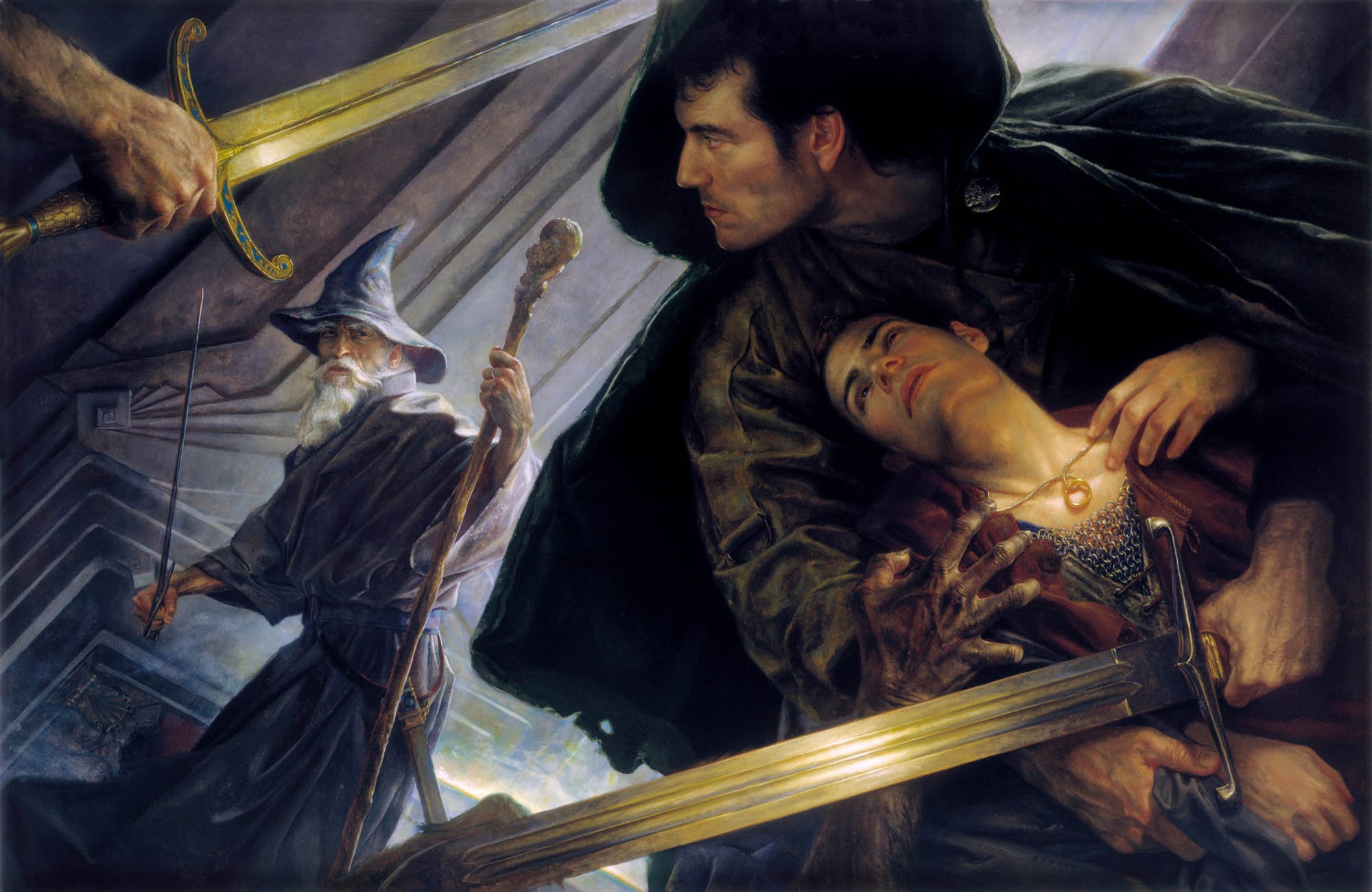
 Interpreting Middle-earth With Artist Donato Giancola
Interpreting Middle-earth With Artist Donato Giancolaauthor
from Tor.com
Fri Aug 19, 2022
When I visited Venice last year, I was overcome by the quality and quantity of the art filling the great halls of the famous Palazzo Ducale (Doge’s Palace). The works of Italian Renaissance painters like Paolo Veronese and Tintoretto surround you and nearly overwhelm you in that place. Saints, kings, soldiers, philosophers, angels, and gods throng the walls, ceilings, and frescoes. But you know, if someone could sneak in an armload of paintings by artist Donato Giancola—paintings like “Gandalf at Rivendell,” “Boromir in the Court of the Fountain,” or “The Tower of Cirith Ungol”—and scatter them around the palace, I bet it would take a good long while for some snooty art historian to notice and complain.
Hell, I probably wouldn’t double-take, either, because those paintings would be perfectly at home there among the masters. I suppose if you put up enough of Donato’s masterpieces in the Louvre or the Met, maybe tourists would eventually wonder why Satan looks an awful lot like a Balrog or ask who all those stressed-out, grey-robed, pipe-smoking old men are, and hey, what’s that blonde lady doing with a sword and, whoa, is she facing off against a headless, mace-wielding black knight who’s just been unhorsed from some kind of pterosaur? What Greco-Roman myth is that even from?!
Personally, I was sold on Donato Giancola’s work the moment I first saw his illustrious and mesmerizingly expansive “Beren and Lúthien in the Court of Thingol and Melian.” I later contacted him to ask if I could include some of his art in  The Silmarillion Primer. Not only was he cool with it, he turned out to be a surprisingly down-to-earth fellow, and it was only a matter of time before I roped him in for an interview. Good timing, because he’s got a great new book out, too.
The Silmarillion Primer. Not only was he cool with it, he turned out to be a surprisingly down-to-earth fellow, and it was only a matter of time before I roped him in for an interview. Good timing, because he’s got a great new book out, too.
In the book’s Introduction, fellow Tolkien illustrator and Middle-earth luminary  Ted Nasmith writes:
Ted Nasmith writes:
Doubtless the most striking aspect of Donato’s artwork is the impression that he stepped out of an 18th century French or Italian atelier, of course.
And Ted of all people would know!
Need some more proof? Have a look at Frodo here, languishing in torment at the hands of his orc captors in the Tower of Cirith Ungol. You know, before Sam arrives to show them who’s boss.
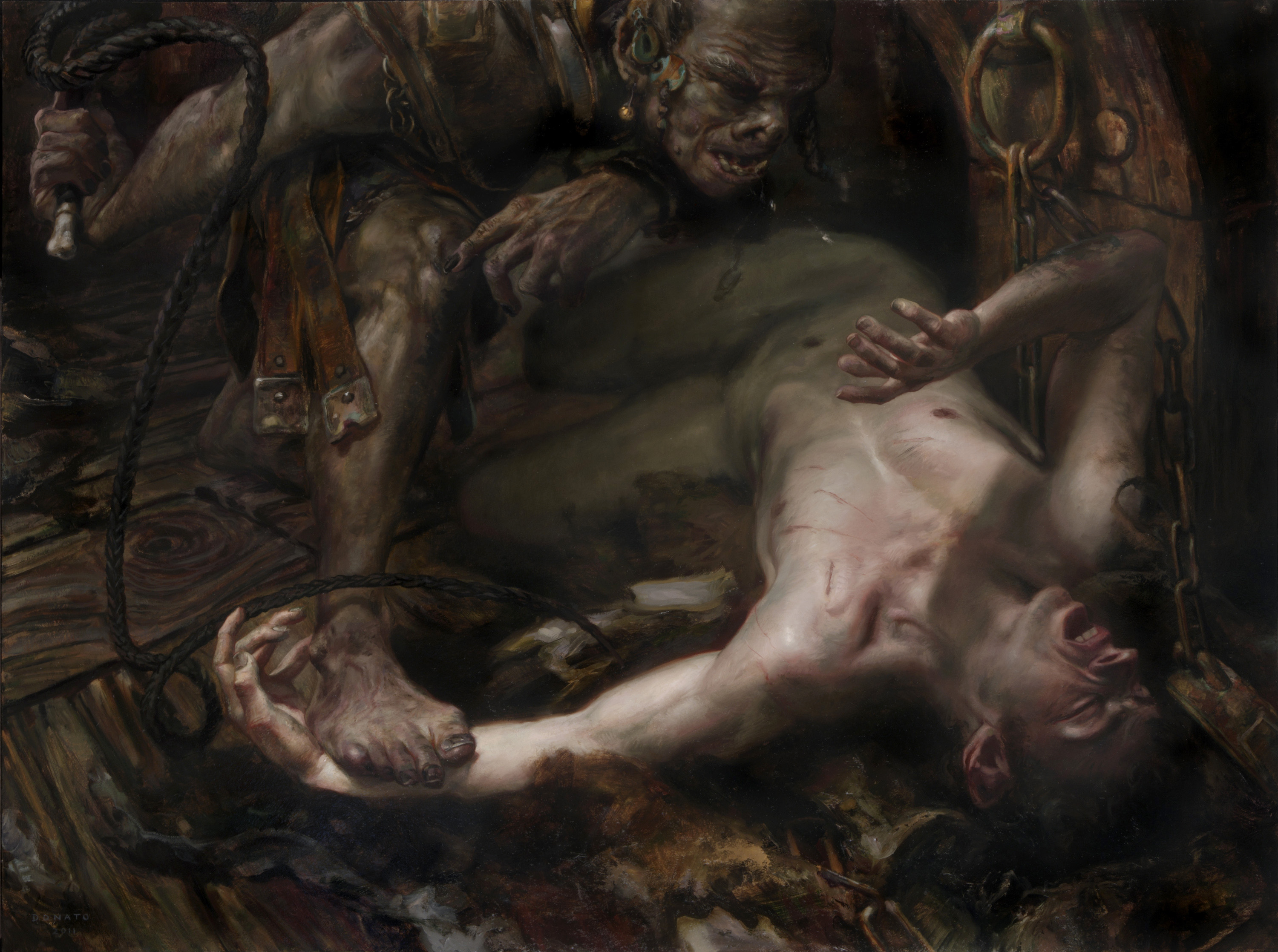
“The Tower of Cirith Ungol” by  Donato Giancola
Donato Giancola
If you’d never seen this piece before but someone told you with a straight face that it was painted by Anglo-Swiss artist Henry Fuseli—perhaps as a follow-up to his famous “ The Nightmare“—you’d have to believe it for a few moments. Of course, this one’s more like Frodo’s nightmare…
The Nightmare“—you’d have to believe it for a few moments. Of course, this one’s more like Frodo’s nightmare…
Still,  Donato Giancola isn’t just a Tolkien artist. He’s a teacher at Manhattan’s School of Visual Arts and an award-winning painter who’s done an unfathomable amount of work for Wizards of the Coast, LucasFilm, a bunch of magazines and video games, and basically all the major book publishers (which includes Tor!). But I’ve cornered him here to talk specifically about his Tolkien treatment. In fact, he’s just released his second art book on the subject, and it’s incredible.
Donato Giancola isn’t just a Tolkien artist. He’s a teacher at Manhattan’s School of Visual Arts and an award-winning painter who’s done an unfathomable amount of work for Wizards of the Coast, LucasFilm, a bunch of magazines and video games, and basically all the major book publishers (which includes Tor!). But I’ve cornered him here to talk specifically about his Tolkien treatment. In fact, he’s just released his second art book on the subject, and it’s incredible.  Middle-earth: Journeys in Myth and Legend, by Dark Horse Books, has nearly two hundred illustrations that offer a fresh take on the characters and realms of the professor’s glorious world. Fresh and yet somehow invoking classical antiquity.
Middle-earth: Journeys in Myth and Legend, by Dark Horse Books, has nearly two hundred illustrations that offer a fresh take on the characters and realms of the professor’s glorious world. Fresh and yet somehow invoking classical antiquity.
I guess what I’m saying is: Donato is the Tolkien neoclassicist we need right now, but not the one we deserve.
Or do I have that backwards? You know what—let’s just jump to the interview:
Donato, you’re a New Yorker (or, like me, a transplanted one), and it’s 2019, so I have to ask this first: Did you make it to the  Tolkien: Maker of Middle-earth exhibit at the Morgan Library? What did you think, as an illustrator, or as a book fan?
Tolkien: Maker of Middle-earth exhibit at the Morgan Library? What did you think, as an illustrator, or as a book fan?
Donato: Certainly I have stopped in at the Morgan and taken in the Tolkien exhibition there! I am soon heading over for my third visit (the benefits of membership). What is there to say? As a fan it doesn’t get much better than viewing the conceptualizing of Middle-earth through the intimate eyes of the creator. Art and maps, taking in the original cover art created for the first edition of The Hobbit, and browsing various letters where he questions and makes fun of his own writing, it is all pure gold!
One of the issues I was most impressed by, from the exhibit, is the craftsmanship Tolkien brought to his illustrations; they are carefully and beautifully rendered in shape, form, and detail. The passion he had for manuscript illumination is very evident in the small scale the works were executed in and the precision handling of line and color. His thoughtfulness to world-building in words extended into that of visual art as well.
Right. I’m accustomed to thinking of Tolkien’s “secondary world,” as he called it, in a strictly literary sense. But seeing his actual drawings and maps up close really reminds you that he didn’t limit his world to the written world, not even in his own mind.
Next question: In a nutshell, what’s your Middle-earth origin story? We all have one.
Donato: My introduction to Tolkien happened in two ways, first indirectly as I began to play Dungeons & Dragons after being introduced to it in middle school from my friends and participating in the immediately formed after school D&D club. Second, very directly about a year later when my older brother Mike, who was in high school at the time, handed me a book they had just read in English class “You might like this,” he said on a Friday afternoon.
It was The Hobbit.
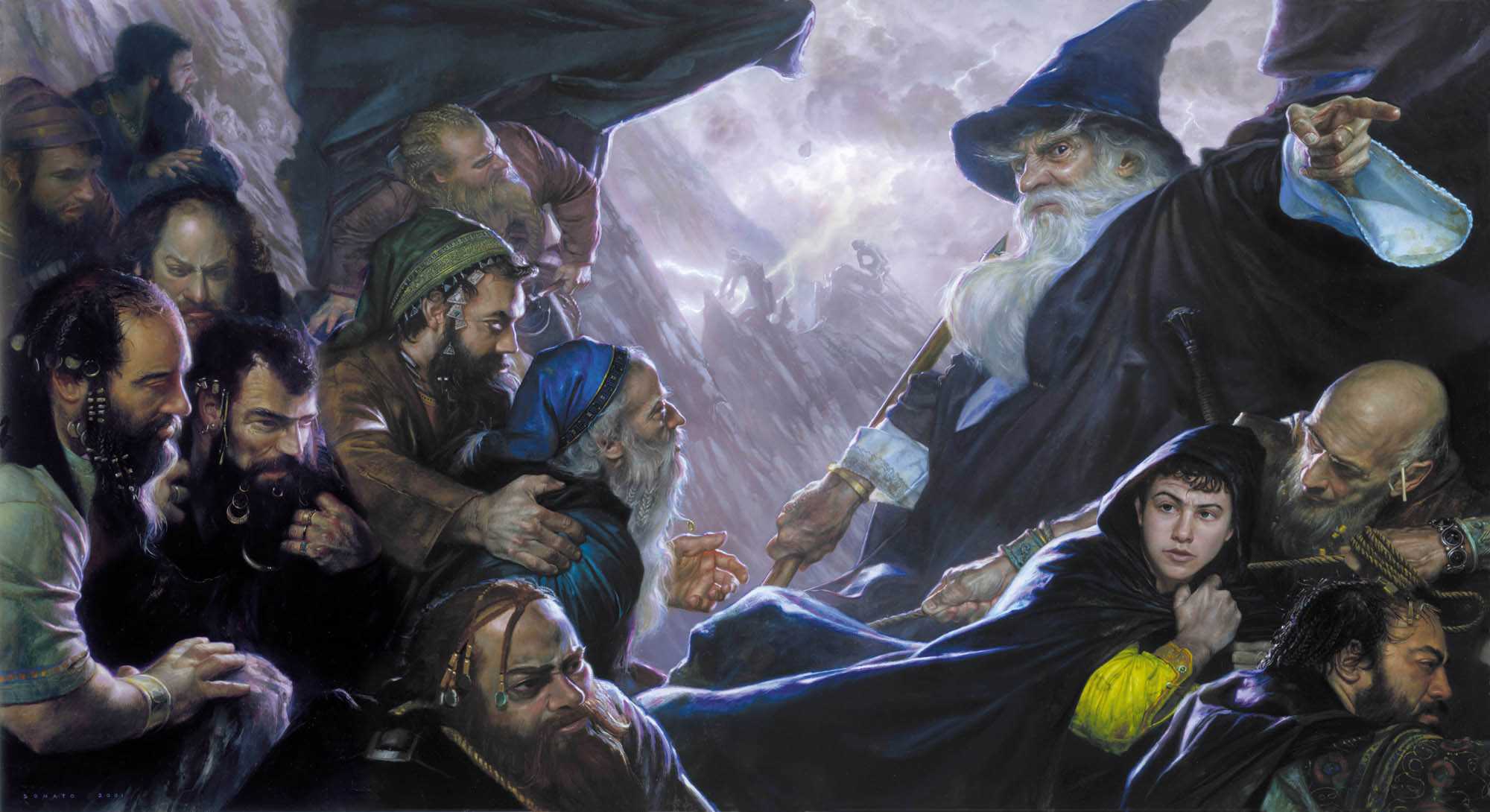
“The Hobbit—Expulsion” by
Donato Giancola (Used with permission of the artist)
I didn’t put it down until it was finished two days later on Sunday. Needless to state, I dove into The Lord of the Rings, The Silmarillion, The Tolkien Companion, The Tolkien Bestiary, and then into Unfinished Tales and the Book of Lost Tales I and II and others as they were released by Christopher Tolkien. I even disrupted my high school silent-reading sessions as I uncontrollably laughed my way through National Lampoon’s Bored of the Rings.
A slight but related digression: I recently came across the entry for wight in the original 1973 “Blue Book.” Back in those days, Tolkien’s influence on the hobby was immediate and obvious, and the references in the game books were often overt.
Barrow wights (as per Tolkien) are nasty nearly immaterial creatures who drain away life energy levels when they score a hit in melee, one level per hit.
As per Tolkien. My point being, to a kid in the 70s or 80s, D&D and Tolkien were like chocolate and peanut butter. You could like one or the other, but if you had both, you were lucky. Bilbo joining up with Thorin & Co. in The Hobbit, and then Frodo’s quest snowballing into the whole Fellowship—these are the prototype adventuring groups. In fact, to quote one caption in your book:
Gandalf had a particular fondness for Bilbo’s maternal ancestors, the curious and intrepid Tooks. This painting depicts an earlier hobbit adventure in the old forest, one that might have inspired Gandalf’s admiring affection for the queer Bucklanders, and eventually led him to Bilbo’s door years later.
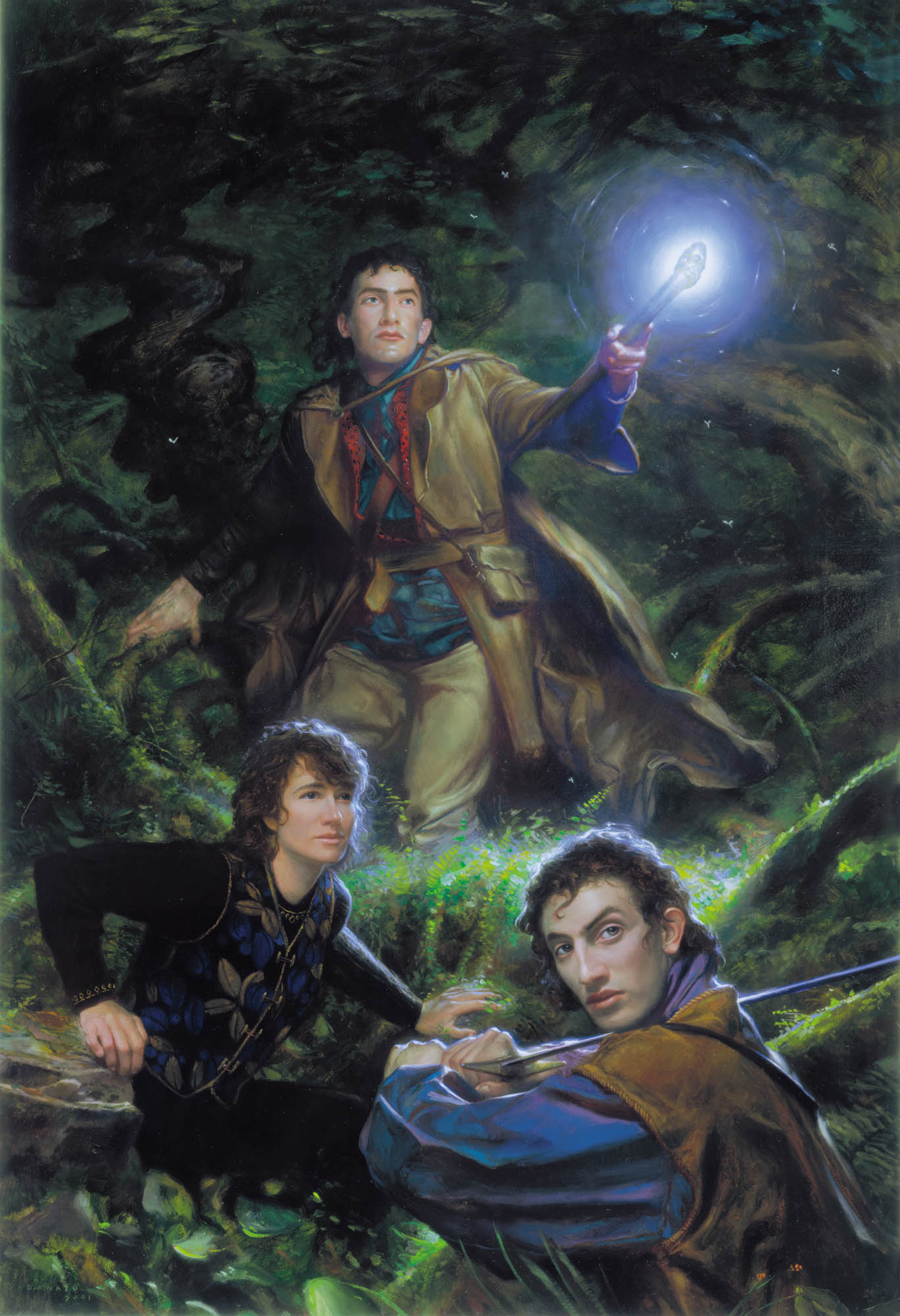
“Then There Were Three” by
Donato Giancola
You can’t tell me that’s not a party of PCs, where each player chose to be a halfling in their DM’s Shire-, Breeland-, and Old Forest-based campaign. (Top to bottom: rogue, bard, fighter, maybe?) And Gandalf definitely loaned that glowing staff to their leader. Anyway, I digress.
People have rightly compared your style to that of Dutch masters like Rembrandt or Italian painters like Caravaggio. And I personally see a touch of John William Waterhouse lurking in there, too. (If you painted Goldberry, I imagine she’d look like a cheerier version of the Lady of Shalott “clothed all in silver-green.”) And this really sets your approach apart, given how much Tolkien’s work likewise evokes a bygone era. There is a synchronicity at work. Given your proclivity for classical realism, is there anything in the legendarium that you find difficult to tackle?
Donato: I am always at odds regarding my realistic approach to interpreting Tolkien’s world, for I believe it was his intent to be as physically vague as possible so that the mental visualizations of all the characters, elements, places, etc. could be manifested with personal integrity within each of his reader’s minds. Did Homer describe the eye color of Odysseus? Do you know what Perseus’ shield looked beyond that of “polished”? Admittedly there are a few specific descriptions, like that of the One Ring or Gandalf’s overall appearance, but tell me, what did the Horn of Gondor looked like? Or the color of Frodo’s shirt? Good luck recalling details, for they are not there.
Thus as a storyteller, I am misguiding audiences by providing details which are not really integral to the story and narrative of the books. But as a visual artist who loves and celebrates high realism, I cannot help but be drawn into making Middle-earth concrete and real. I want to feel it.
I see no harm in that. Absolutely every artist is taking a stand whenever they depict a character’s face. The expression you give a character is just one moment in time. Take “Boromir in the White Mountains.” Readers know the eldest son of Denethor as a tragic figure whose moment of weakness has him taking one for the team, but we’re with him long enough to feel the range of his character. Here he is proud and honorable, but also conflicted.
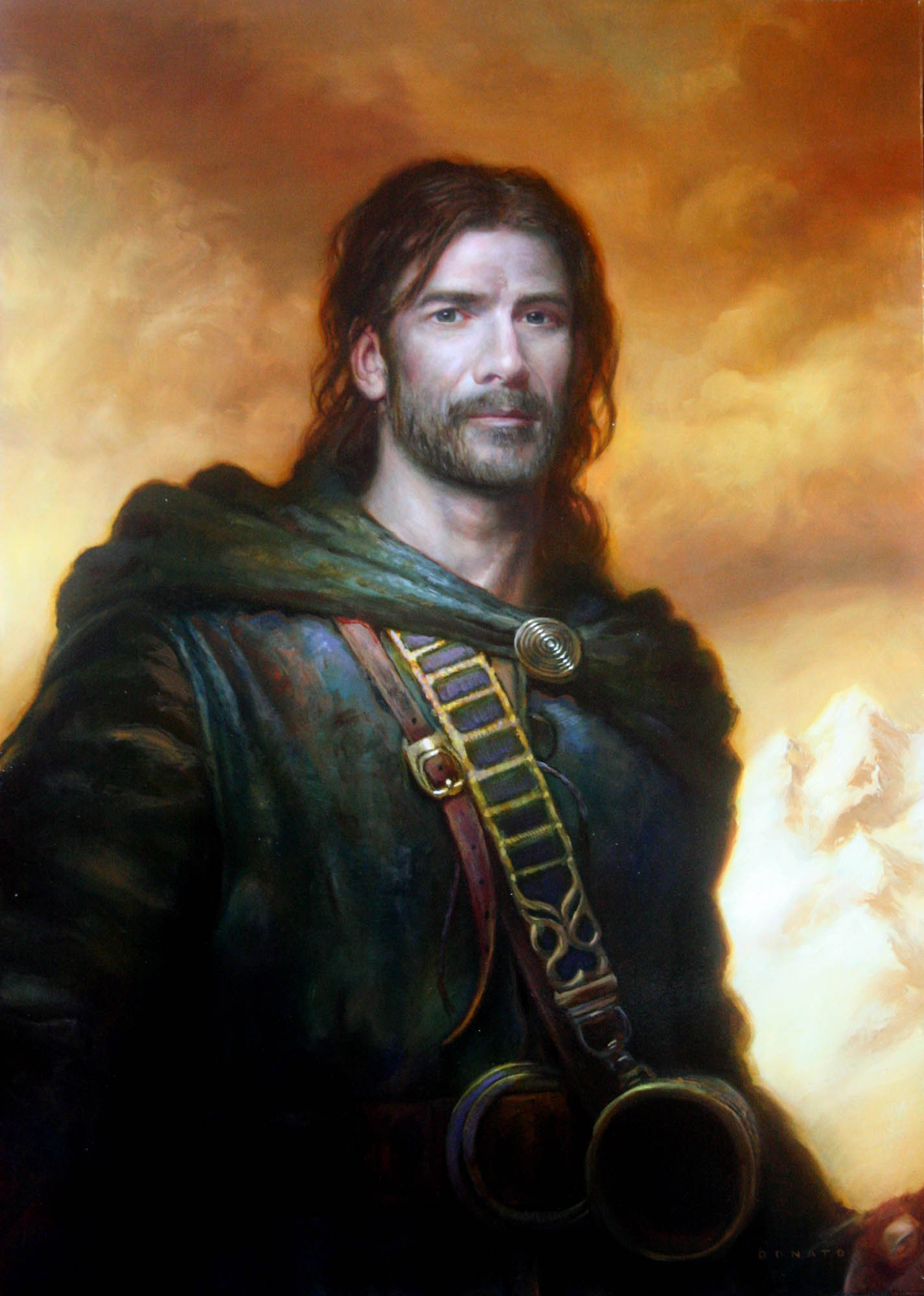
“Boromir in the White Mountains” by  Donato Giancola
Donato Giancola
Donato: In an interesting contrast, my upbringing through various media like The Tolkien Bestiary by David Day, and seeing numerous artists tackle the book covers and calendars (Howe, Lee, and Nasmith rock that area!) set the expectations for me that there is no one correct way to see and interpret the world of Middle-earth. Ian Miller’s Ents are the best, Michael Kaluta’s Éowyn and the Nazgûl is top of the charts for that scene, Nasmith’s Caradhras avalanche was obviously sampled for the Peter Jackson movie, but Jackson’s Riders of Rohan armor and barding are mindblowing! (Actually that should be credited as Weta Workshop’s Riders!) The plurality of valid interpretations of Middle-earth is a gift to those experiencing Tolkien’s world before the movies!
Yeah. I know David Day gets a bad rep among hardcore Tolkien fans (maybe deservedly so), but the guy definitely got some good art out there with his collections.
Donato: Back to your question, is there anything difficult to tackle from the legendarium? Yes. Lots. Melkor. Sauron. The Silmarils. What an Elf or hobbit really looks like. These are all aspects I have no internal visual grounding in. I know what they “felt like” but that is a very different realization than depicting them visually. The Power of Words! Therefore many of these elements change from imagining to imagining within each of my pictures. You can really see this with depictions of Éowyn, Frodo, and Sam in the book, they look different every time, but feel ‘right’ within each image as I use varied emotional bases to tackle the artworks. I still have various actors playing their parts, thus cannot lock down any one particular look to their character!
“Shieldmaiden of Rohan” and “No Living Man” by  Donato Giancola
Donato Giancola
You’re not kidding. “Shieldmaiden of Rohan” almost looks like an adolescent still in training, determined and unafraid, where “No Living Man” looks like Éowyn’s been put to the test, at last. And as for Frodo and Sam, every depiction is different from the previous, from the daring halfling adventurers sketched in “Phial of Galadriel” to the unexpectedly serene “Frodo in Ithilien,” to the stricken hobbits in “On the Steps of Mount Doom.”
Donato: I have the technical facility to paint nearly anything now, from dragons, to demons, to landscapes, to dwarves, to castles, but I still do not know what so much of Middle-earth looks like… I interpret Middle-earth one painting, one emotion, at a time.
“Phial of Galadriel” and “Frodo In Ithilien” by  Donato Giancola
Donato Giancola
I couldn’t agree more. I actually think it’s a great thing when a beloved character is portrayed in so many varied ways. It makes them more mythical, yet accessible—like you’re giving the reader permission to reconstruct their imagination.
I never imagined Legolas to look quite like Orlando Bloom’s when Jackson’s films came out, but I found it easy to accept that vision. Yet when I see others, his form is reshaped in my mind without a problem. Your book helps with this. Your Legolas, for example, has an indigenous look in several sketches and paintings, which actually feels right considering that Elves are bonded with the natural world in ways mortal Men never are.
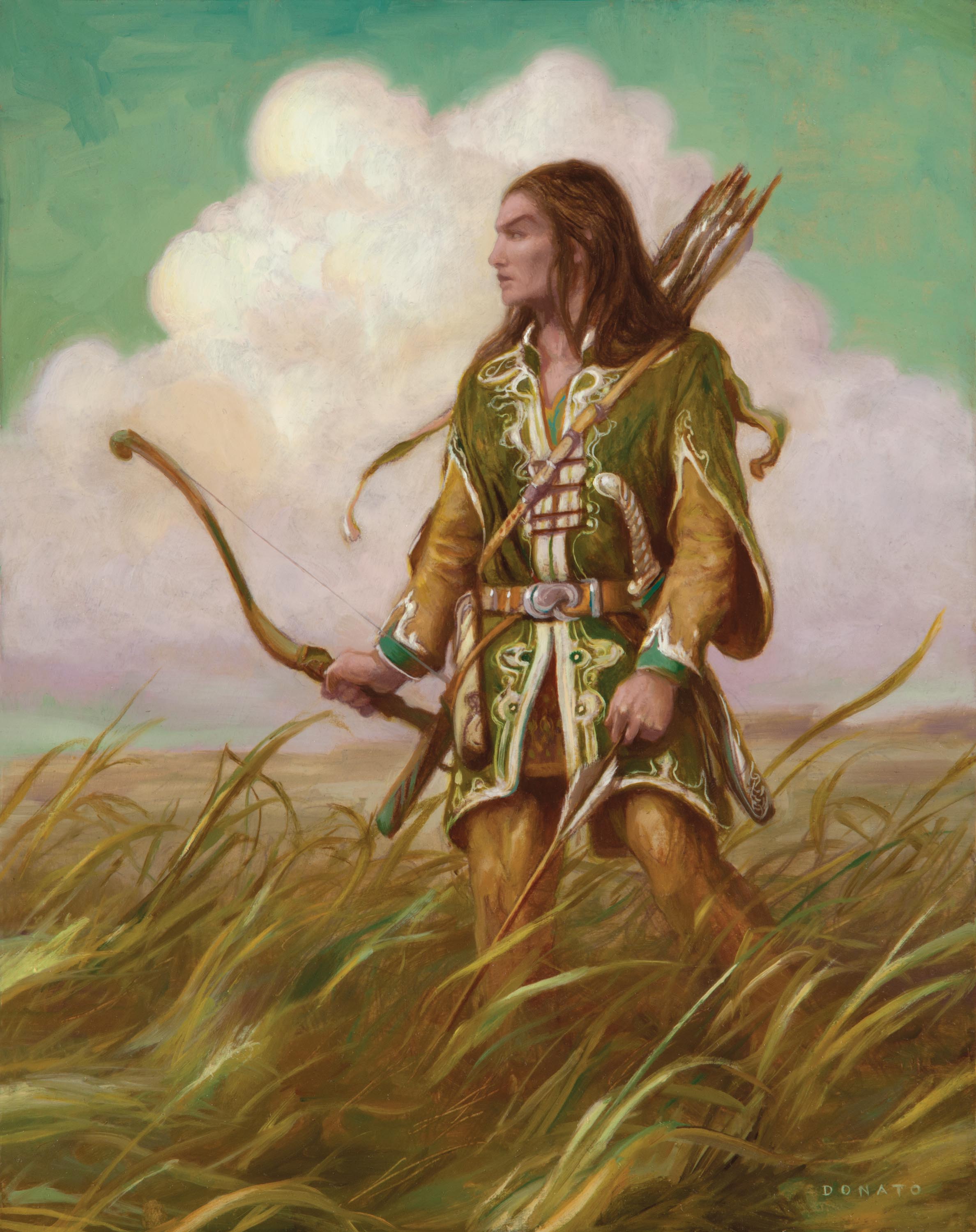
“Legolas” by  Donato Giancola
Donato Giancola
One of my favorite sketches is “Saruman—Doubt” precisely because it’s a rare glimpse of the wizard that we just don’t see in The Lord of the Rings, but it’s surely a moment that exists behind closed doors. There are the accounts of Saruman in “The Hunt for the Ring” chapter of Unfinished Tales, wherein Tolkien more thoroughly lays out the predicament the White Wizard has placed himself in treating with Sauron. Not to mention the fear and regret that comes with it. I’m fascinated by the tragedy of Saruman, so these drawings are perfect for me.
Saruman still looks threatening here, but there’s a holy-shit-what-have-I-done? tension in his posture.
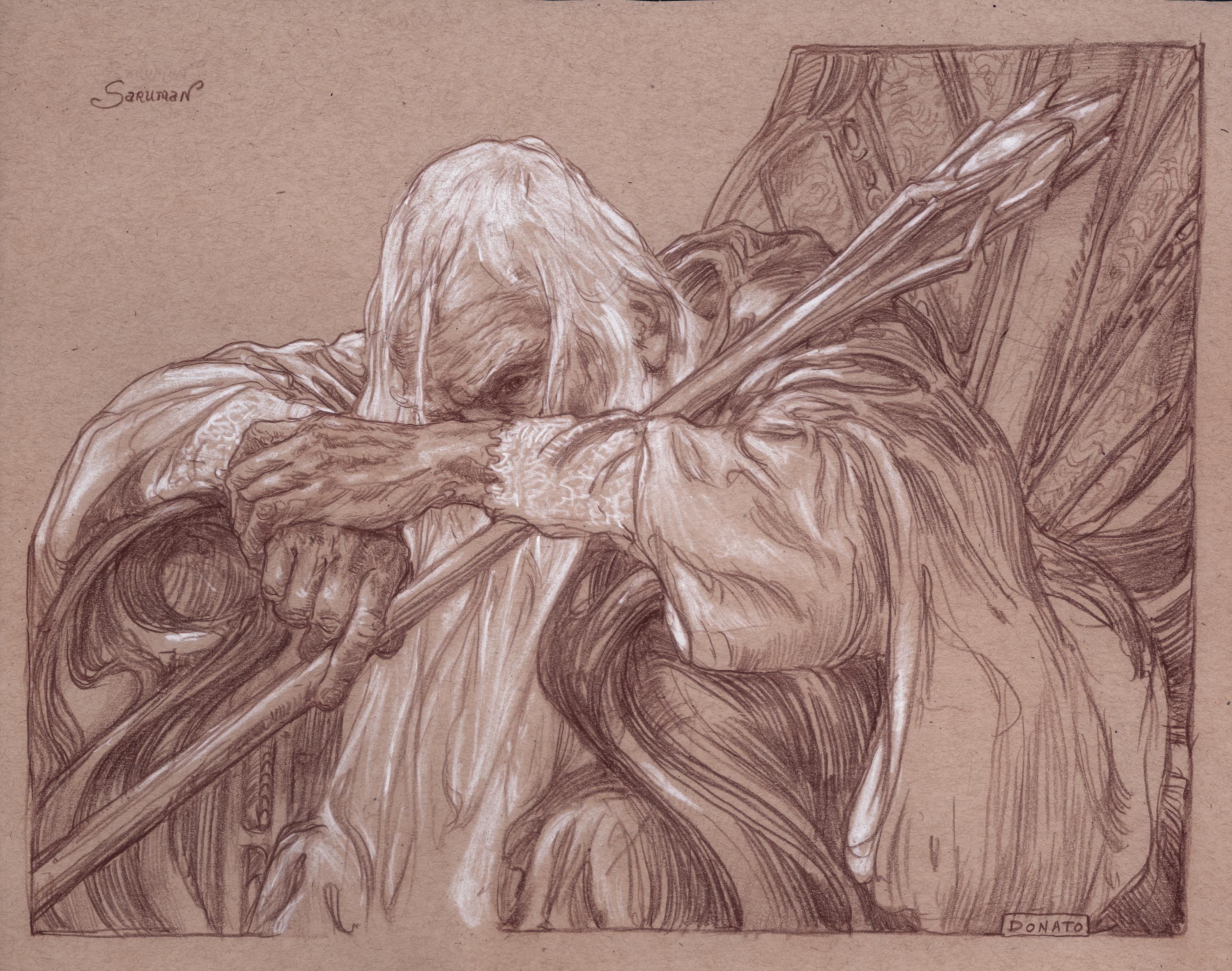
“Saruman—Doubt” by  Donato Giancola
Donato Giancola
What’s the story of this sketch, and your other Sarumans? What made you settle on the final pose your colorized oil painting “Saruman—Corruption”? He looks soured by guilt, not the vicious pride he displays on the balcony of Orthanc. But he seems to be just taking a moment to breathe.
Donato: What captivates me about Saruman is his connection with Men, from taking his home in one of the great towers from the Númenóreans, and being twisted by Sauron through the desire for power and the Ring like the Nazgûl. His fate must have begun similar to what Boromir experienced, seeing the power the Ring held and wishing to manipulate it for good. For me this makes Saruman the more “mortal” of the Istari and therefore more prone to human emotions. Therefore I love to play on these ideas of the corruption of the wizard’s mind.
Although Boromir and Saruman likely began their descent in a similar fashion, Boromir was spared from the decline into what his forefather Isildur became, but not Saruman. We see Saruman in The Lord of the Rings hundreds of years after this initial affliction, near the end of the corrupting disease, and distortions of his mind provided from Sauron through the palantír.
Much of my inspiration for character portrayal comes from expressive human emotions. How do we see/feel doubt? Reluctance? Hundreds of hours of life drawing have been critical in informing me in the fascinating dynamic poses and expressions the human body can take. It was just such a sketch which helped move this concept forward—the wasted, tired figure, a glance lacking confidence, the hands loosing their grip on the staff (a symbol of power), all of these subtle elements come into play in creating the mood of the work.
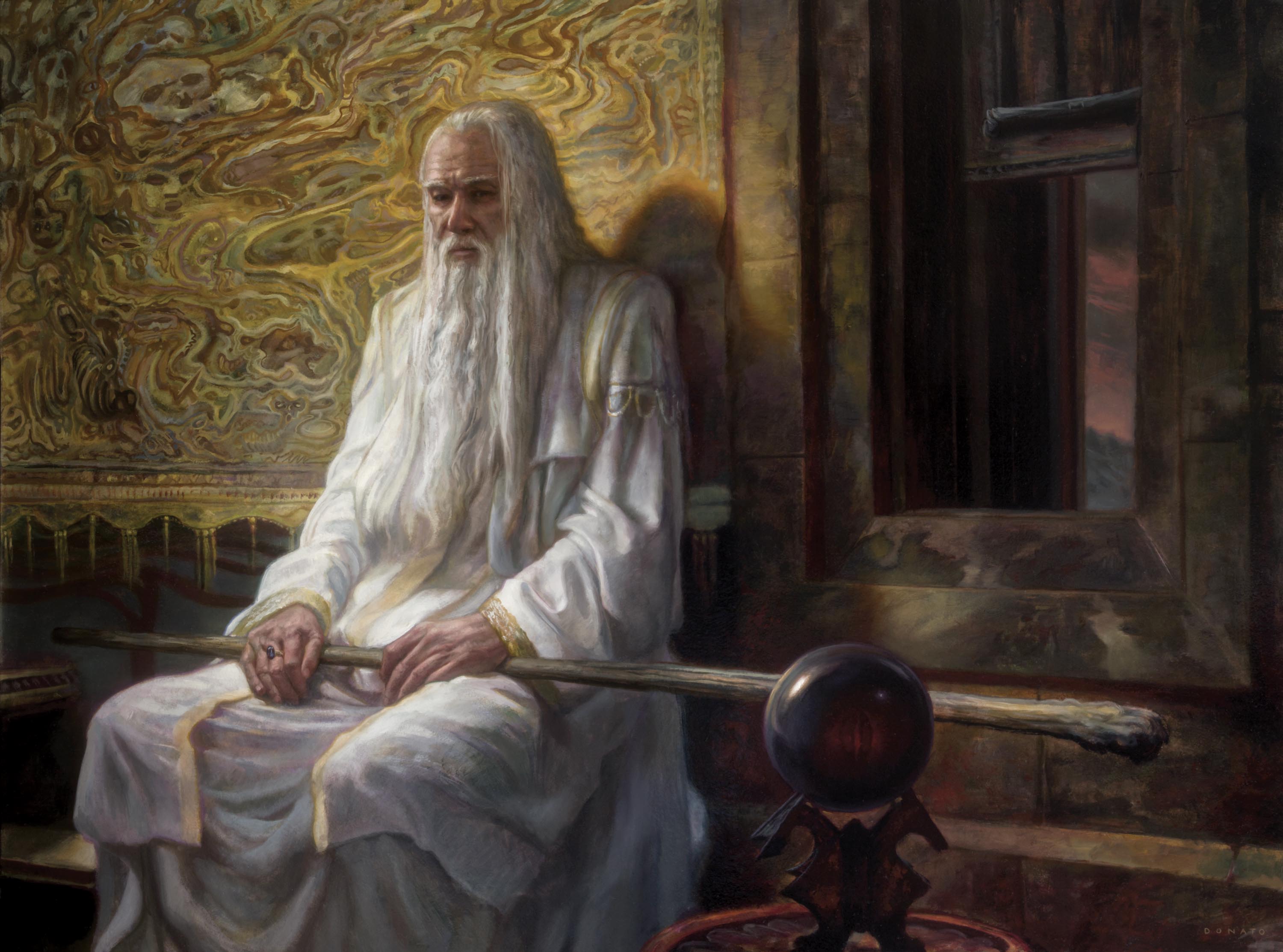
“Saruman—Corruption” by  Donato Giancola
Donato Giancola
That’s exactly it. A letting go of that confidence. That’s precisely what you rendered. That humanity, even in an immortal Maia, feels way more accessible in this medium.
Donato: I was lucky enough to have created a painting a few years before “Saruman—Corruption” about a knight reluctant to go to battle. The acting and posing the model executed for this commission helped inform my sketching. It was the idea of a seated figure, energies spent, which brought this concept of Saruman into final clarity.
It’s one my favorites now. So who, beyond Tolkien, are your literary heroes? Is there another fantasy or science fiction series you would enjoy illustrating?
Donato: Ursula K. Le Guin’s work has been a deep inspirational source these past years. I would love to interpret novels like The Dispossessed and The Left Hand of Darkness, books within her Hainish Cycle, which while not a series, are placed within a similar universe. And compared to Tolkien for visual details, Le Guin has us nearly walking visually blind in her worlds. There is so much to interpret here, and I love that fact that nearly all the basis for illustrations would come from emotional, social relationships.
Well now I really just want to see your take on Sparrowhawk and Tenar from her Earthsea books. So thanks for that.
And now I’m going to pull something from the FAQ on your website when you were asked if music ever inspired you. To which you answered: “The Minimalist music of Steve Reich and Philip Glass mimics some of the patterning I used in my art, but my tastes run larger, too. I love to listen to whatever John Schaefer chooses to play on WNYC as well as alternative rock, and Rush for nostalgia’s sake!”
Man, you can’t swing a dead orc in room full of Tolkien nuts without hitting a few Rush fans, can you? I love it.
Philip Glass is excellent, too, and hey, my brother had some of his music played on  John Schaefer’s New Sounds once! Small world. So are there any other bands or musicians you can name regarding alternative rock, since you name-dropped Rush there? I am always interested in the other influential forms of media that percolate in the minds of fellow Tolkien fans.
John Schaefer’s New Sounds once! Small world. So are there any other bands or musicians you can name regarding alternative rock, since you name-dropped Rush there? I am always interested in the other influential forms of media that percolate in the minds of fellow Tolkien fans.
Donato: I wish I had more references or suggestions on the music front, but I have mostly listened to John Schaefer’s New Sounds because its parent broadcaster, New York Public Radio, is my go-to setting on the stereo in the studio. I love the diverse guests and content that streams over NPR—art, literature, history, politics, pop-culture, etc. It keeps me grounded in local and global events. I’ve tried audiobooks, but have never gotten past ANY first chapters—I just hate being read to I guess.
But I do love theater and modern performances. The Brooklyn Academy of Music (BAM) is a 10-minute walk from our place and we are always catching shows and events there. My first viewing of Godfrey Reggio’s and Phillip Glass’ groundbreaking film collaboration Koyaanisqatsi was on the giant screen at BAM while Glass and his Ensemble played the music live! What an experience!
BAM and their New Wave Festival has been an annual inspiration for me, from creative stage designs to contemplative and challenging music.
On the stay-at-home side, I love to read. I entertain a little, dabble in SF and Fantasy, but also into modern fiction and non-fiction—science writings from Richard Dawkins to fiction by Ursula Le Guin, The Things They Carried by Tim O’Brien to On Ugliness by Umberto Eco, my tastes are very diverse! All of this goes to fuel the creative impulses…
NPR. BAM. You’re such a New Yorker. I approve!
All right, so here’s my first hypothetical: if you were to receive an exclusive, never-before-seen description—as in from the hand of Tolkien himself—of one remote place or one lesser known character in Arda, what would you choose? Something we never see or know much about that you’d enjoy getting intel on and depicting.
Donato: What I love about Tolkien’s writing is that he tends to avoid highly specific visual descriptions. Certainly places have form—Gondolin on a rocky mound in the middle of a flat plain surrounded by mountains, the Black Gate stretching from one side of the valley to the other with the Teeth of Mordor perched on the flanking hills—but Tolkien’s real power is in the “feel” of these places.
One area I would love to feel more about are the Dwarven kingdoms. I do not think we really got to know the Lonely Mountain. And the Iron Hills, Belegost, and Nogrod are just hinted at. What about the other kingdoms of the Dwarves? I would like to see how Tolkien would describe Moria, not as in the Fellowship of the Ring, but in a walk through during the Second Age, at the height of its glory. That would be exciting to see come to life in my mind through Tolkien’s words!
The Dwarf mansions, heck yeah! You did depict Telchar of Nogrod forging Narsil, at least. If only we could pan out, see his forge, and then get a tour of his estate!
Now, if they ( Amazon or whoever) made an animated anthology-style series for The Silmarillion and you were approached to provide concept art for one of its stories, which would you choose?
Amazon or whoever) made an animated anthology-style series for The Silmarillion and you were approached to provide concept art for one of its stories, which would you choose?
Donato: One of my favorite stories from The Silmarillion is the Lay of Leithian (who doesn’t enjoy this epic?). What the tale offers with the meeting, bonding, and adventures of Beren and Lúthien is a wonderful trip through diverse parts of Middle-earth. From Beren’s upbringing in Dorthonion to the Caves of Menegroth to the Isle of Werewolves into Angband and back once again to Doriath. Plenty of places to visualize, so many characters to consider! We could even pay a visit to Valinor to retrieve Beren from the dead!
See, that’s perfect. I so want to see the Halls of Mandos…and yet not have it too fully revealed and lose its mythic quality. What a line to walk. By the way, your two-page spread of the court of Thingol and Melian is breathtaking. Anyone who’s ever seen this piece, which I also used in my Primer treatment of the Beren and Lúthien story, ought to go see  your photos of the painting process on Muddy Colors. The size of that thing!
your photos of the painting process on Muddy Colors. The size of that thing!
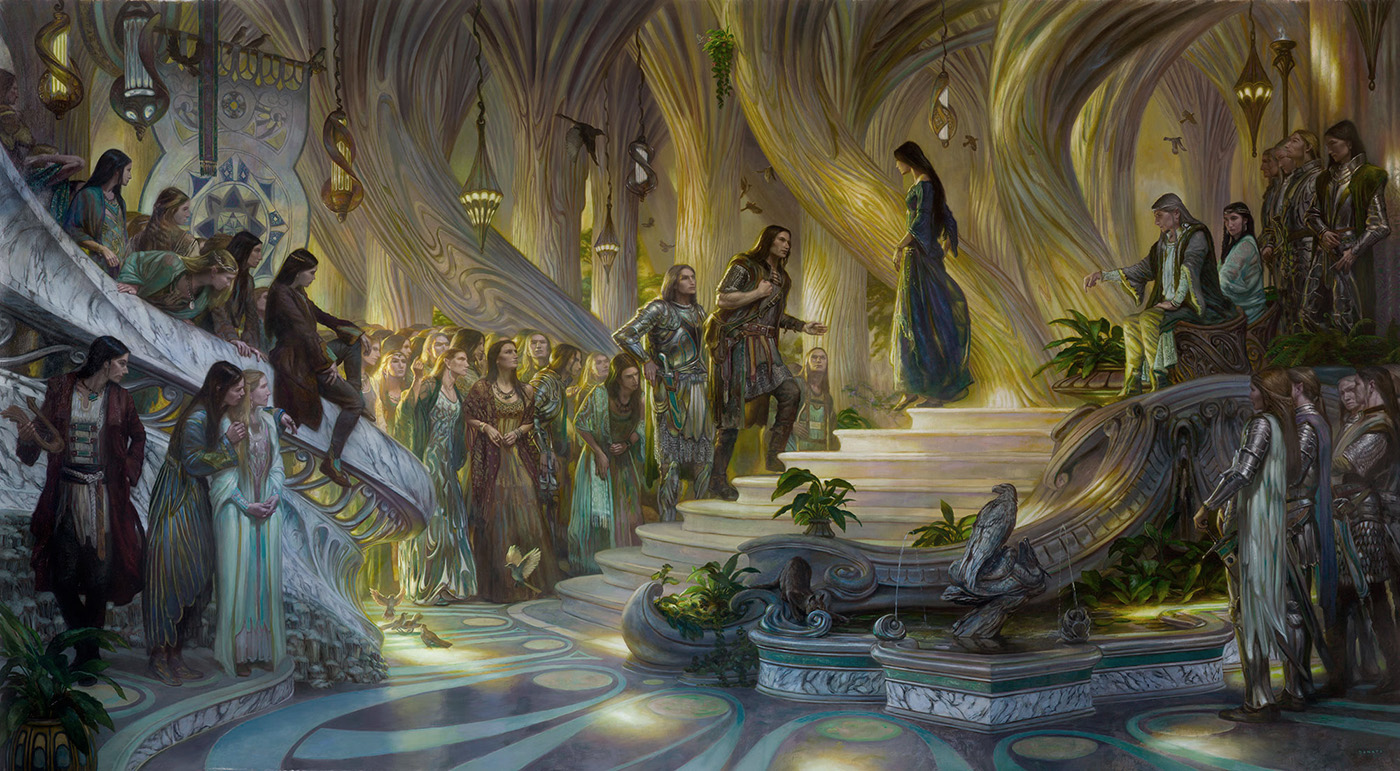
“Beren and Lúthien in the Court of Thingol and Melian” in Middle-earth: Journeys in Myth and Legend
Now for some easier lightning-round questions. Regardless of the subjects of your own illustrations, who is . . . your favorite Elf of the First Age?
Donato: Beleg. Noble, a true friend and unintentionally slain for his loyalty. A tragic ending to his life.
Beleg! That’s why you sketched him in the book, too!
Favorite mortal man or woman of the First or Second Age?
Donato: Túrin. You see the pattern here. I love tragedy!
And Tolkien’s work, especially in the First Age, sure is overflowing with it.
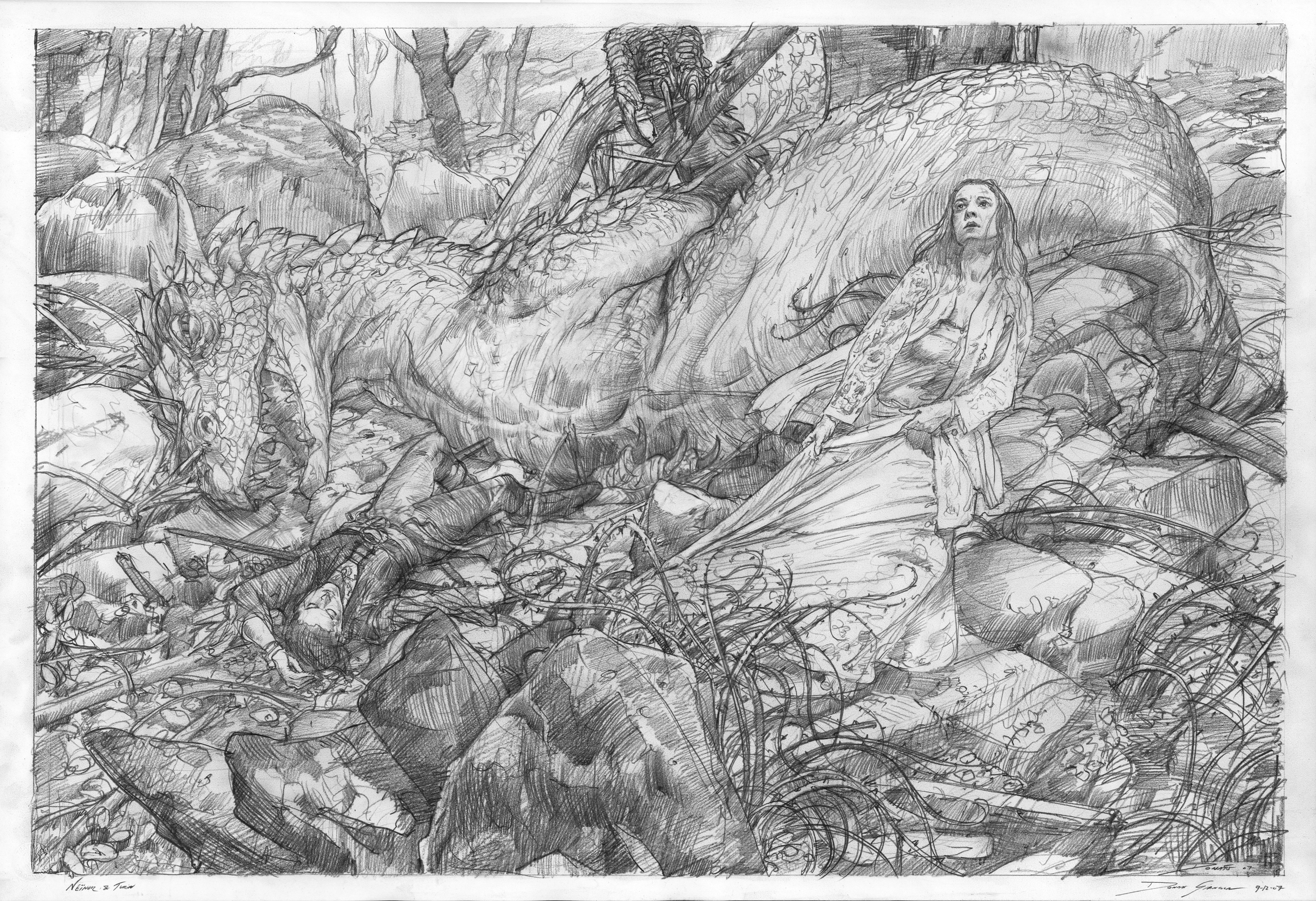
“Nienor and Túrin” by  Donato Giancola
Donato Giancola
Favorite monster of Morgoth?
Donato: Is Sauron a monster?! We could argue that. My alternative pick are the Balrogs!
Which of the Valar do you wish Tolkien had told us more about?
Donato: Yavanna. I love the idea of hearing more about her works in Middle-earth.
She’s got the lion’s share of work on Middle-earth, too. All that nature!
A Dwarf you wish we knew much more about?
Donato: Thorin’s grandfather, Thrór!
Favorite D&D monster? Trick question!
Donato: Do I have to pick just one?? Then it will have to be . . . Trolls! Devastating Claw/Claw/Bite and regenerate 3 HP per round. Every party’s nightmare. (I was a DM!)
Hah! Unless you’ve got fire or acid, now they regenerate 10 hit points per round. Fifth Edition D&D ain’t your grandpappy’s D&D. All right, how about favorite race/class combo?
Donato: Elf wizard…but only if the DM waives the max level restriction (I am 1st Edition Old School). Rules are made to be broken. :)
Totally. Well, you’ll be happy to know that they dropped the racial level caps long ago. So what are you working on now?
Donato: Slowly building for the past decade has been my passion for science fiction robots. As an initial milestone, I have just released the first teaser collection as a 28-page booklet—
Empathetic Robots. I will launch into creating more of these images as the year progresses and hope to have a more thorough narrative and world built around them by the beginning of next year!
That’s right, I’ve seen some of those images popping up on  your Instagram page! They’re pretty sweet. I daresay some of those androids make me think of the warforged, a race of living constructs from Wizards of the Coast’s Eberron setting…
your Instagram page! They’re pretty sweet. I daresay some of those androids make me think of the warforged, a race of living constructs from Wizards of the Coast’s Eberron setting…
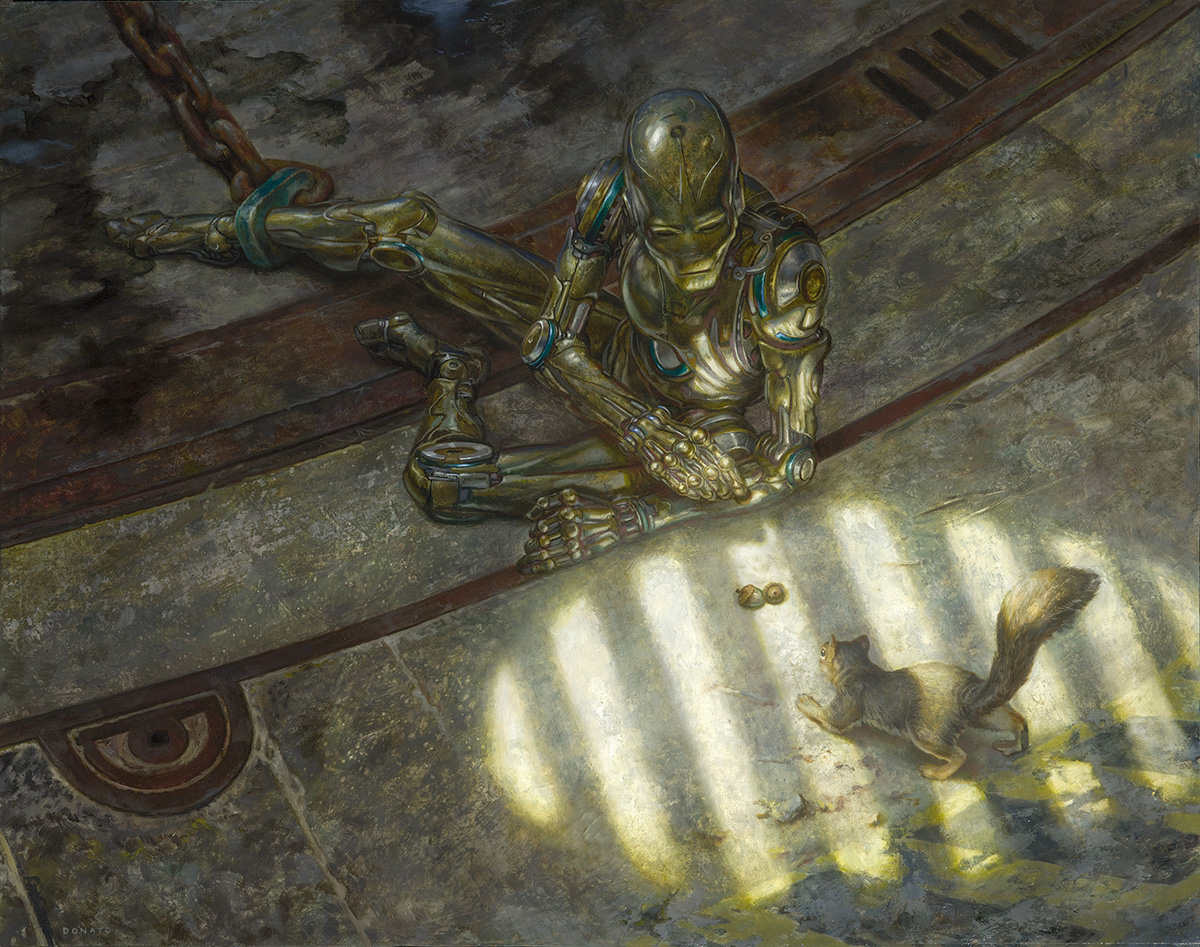
“Empathy” by  Donato Giancola
Donato Giancola
Donato: On other fronts, my fascination with astronauts and space exploration continues in the ongoing Extended Universe series as well as further commercial commissions with book publishers and game companies.
Extended Universe…? Wait, Star Wars, now? Are there any great franchises you want to leave alone already? (I kid, I kid. Keep doing all this.)
Donato: Lastly, with the huge success of the Middle-earth: Journeys in Myth and Legend, already into its second printing before first editions are on the shelves, there is talk of an updated version in a couple of years…so more visuals will be forthcoming from Middle-earth!
Any chance you can be steered into rendering more from The Silmarillion? I would love to see Finrod Felagund, Hewer of Caves, hanging out in his halls of Nargothrond. Or maybe Finrod in the company of Beren, maybe as he’s weaving his spells over their company so they can pass as Orcs! Or maybe Finrod just hanging out with his buddy Bëor the Old. You see the pattern here. I love Finrod.
Donato: The Silmarillion is indeed on my catch-up list to fill out visualizations of Middle-earth, but it’s hard to know which stories I will tackle. So many, where to start? Finrod is a favorite, thus I am sure he will land a color image at some point.
You had me at “Finrod is.” I can’t wait. Thank you for your time, sir!
Folks,  Middle-earth: Journeys in Myth and Legend is an elegant coffee table book jam-packed with Tolkien goodness, and Donato Giancola’s devotion to the craft of depicting this world is meritorious. I challenge anyone to flip through his illustrations and imagine which room in the Metropolitan Museum of Art each painting could theoretically be placed. I for one am happy imagining Gandalf sitting pretty beside Rembrandt’s self portrait in Gallery 964 at the MET as part of the Dutch Masterpieces exhibit. (So what if Giancola is an Italian name.)
Middle-earth: Journeys in Myth and Legend is an elegant coffee table book jam-packed with Tolkien goodness, and Donato Giancola’s devotion to the craft of depicting this world is meritorious. I challenge anyone to flip through his illustrations and imagine which room in the Metropolitan Museum of Art each painting could theoretically be placed. I for one am happy imagining Gandalf sitting pretty beside Rembrandt’s self portrait in Gallery 964 at the MET as part of the Dutch Masterpieces exhibit. (So what if Giancola is an Italian name.)

“Self-Portrait, 1660″ by Rembrandt / “Do Not Tempt Me” by  Donato Giancola
Donato Giancola
One of those two men was a prolific and world-famous draughtsman, painter, and printmaker. The other went toe-to-toe with a Balrog.
This month, we’re celebrating the legacy of J.R.R. Tolkien with a look back at some of our favorite articles and essays about Middle-earth. A version of this article was originally published in April 2019.
 Jeff LaSala is thinking about revisiting Venice in the dead of night, clad in black and armed with a flashlight and a Giancola original. Hopefully the Carabinieri will go easy on him. Tolkien geekdom aside, Jeff wrote a Scribe Award–nominated
Jeff LaSala is thinking about revisiting Venice in the dead of night, clad in black and armed with a flashlight and a Giancola original. Hopefully the Carabinieri will go easy on him. Tolkien geekdom aside, Jeff wrote a Scribe Award–nominated  D&D novel, produced some
D&D novel, produced some  cyberpunk stories, and now works for Tor Books. He sometimes flits about on
cyberpunk stories, and now works for Tor Books. He sometimes flits about on  Twitter.
Twitter.
© 2023 Macmillan | All stories, art, and posts are the copyright of their respective authors
Science fiction. Fantasy. The universe. And related subjects.

Images and artworks on this page are Copyright © Donato Giancola. No images may be downloaded or used without explicit permission of the copyright holder. All Rights Reserved.